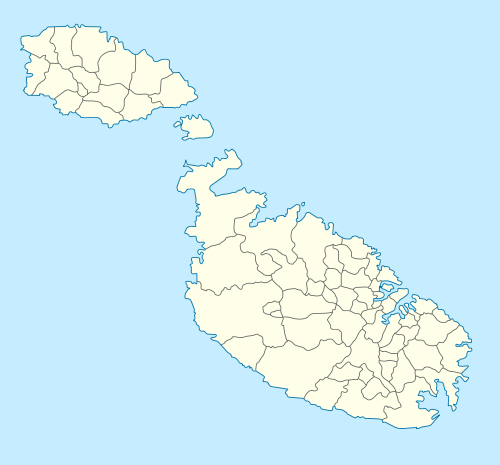Ġebel ġol-Baħar
| Ġebel ġol-Baħar | |
|---|---|
 | |
| Location | off St. Julian's, Malta |
| Coordinates | 35°55′57.2″N 14°29′44.3″E / 35.932556°N 14.495639°ECoordinates: 35°55′57.2″N 14°29′44.3″E / 35.932556°N 14.495639°E |
| Part of | Megalithic Temples of Malta |
| Height | 6–10 m (20–33 ft) |
| History | |
| Material | Limestone |
Ġebel ġol-Baħar is a possible megalithic temple located underwater off the coast of St. Julian's, Malta. The site was identified in 1999 by Dr Hubert Zeitlmair, but it was never studied properly and archaeologists are not convinced that the site is actually a temple.
Site
The site is located on an underwater plateau approximately 2km off the coast of St. Julian's. The plateau is 900 by 500 metres long, and its highest point seems to be man-made, and is 19 metres below sea level.
The site contains large boulders which seem to be man-made and not natural, and are covered in vegetation. The structure consists of a cluster of three stone circles. There are 'rooms' with a diameter of 9 to 11 metres, with parts having a height up to 6 to 10 metres. An 'avenue' goes up to the entrance of the structure, which faces east. Tracks on the seabed resembling cart ruts were also observed on the site.[1]
According to some sources, the site may to be "the largest known prehistoric complex on Earth".[2]
There are several other underwater archaeological sites in Malta. Underwater cart ruts can be seen near the shore of St. George's Bay in Birżebbuġa, close to the megalithic temple of Borġ in-Nadur. According to 16th and early 17th century sources, another megalithic structure existed in the Grand Harbour, near the foot of Fort Saint Angelo.[3] Other megalithic stone circles also allegedly exist at Sikka l-Bajda, but these have not been proven.[2]
Discovery
The site was discovered on 13 July 1999 by Shaun Arrigo and his brother Kurt, who were working under the instructions of Dr Hubert Zeitlmair, a retired German real estate investor interested in pseudoarchaeology. He believes that the temple was built by aliens in around 10,000 BC to 12,000 BC, and was submerged at the end of the Ice Age during the Genesis flood narrative.[4] This does not fit within Malta's prehistoric chronology since the earliest known human habitation of the island began in the Għar Dalam phase in around 5000 BC.
According to Zeitlmair, the site bears similarities to the temple of Ħaġar Qim on mainland Malta.[2] The site was given the name Ġebel ġol-Baħar, meaning "Stones in the Sea" in the Maltese language.
The discovery was reported in the local media in October 1999, but after some time interest died down.[1]
Further explorations of the site were conducted by Zeitlmair in November 1999 and May 2000.[5]
The site has also been linked with the island of Atlantis,[6] and Zeitlmair has published a book about this in German.[7]
Analysis
Maltese archaeologists are not convinced that the site is a megalithic temple.[3] Other people who dived there said that the boulders which make up the site are not megalithic, but are modern ones which were dumped illegally.[1]
In 2013, marine scientists at the University of Malta discovered that 20,000 years ago, the Maltese islands were indeed much larger, and were connected to Sicily with a land bridge. However, there was no mention of Ġebel ġol-Baħar during the studies.[8]
References
- ↑ 1.0 1.1 1.2 Micallef, Etienne (2006). "16th May 2006 - The Cornerstone of Atlantis Seminar" (PDF). The Oracle. Calypso Sub Aqua Club. pp. 20–21. Retrieved 27 April 2015.
- ↑ 2.0 2.1 2.2 "Malta's Antediluvian Temples". taboodata.com. 1 May 2011. Retrieved 27 April 2015.
- ↑ 3.0 3.1 Coppens, Philip. "Malta: the small island of the giants". philipcoppens.com. Retrieved 27 April 2015.
- ↑ O'Connell, Tony. "Hubert Zeitlmair". Atlantipedia. Retrieved 27 April 2015.
- ↑ Zeitlmair, Hubert; Zeitlmair, Dagmar. "Report of marine exploration at the underwater temple site of Ĝebel Ĝol-Bahar in May / June 2000". maltadiscovery.org. Retrieved 27 April 2015.
- ↑ "Underwater Temples & Atlantis". carnaval.com. Retrieved 27 April 2015.
- ↑ Zeitlmair, Hubert (2001). Die Säulen von Atlantis - Malta. Ancient-Mail-Verlag. ISBN 9783935910002.
- ↑ "Malta 20,000 Years Ago". University of Malta. 2013. Retrieved 27 April 2015.